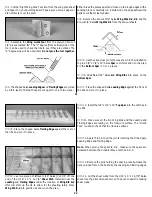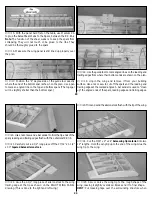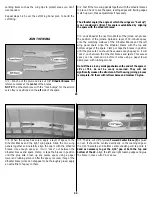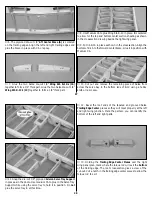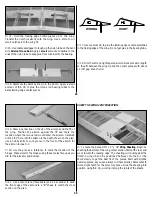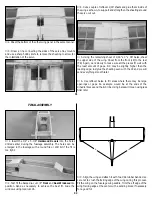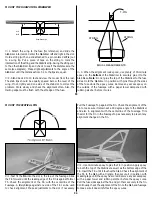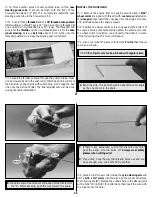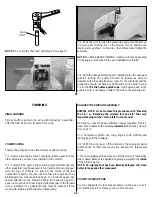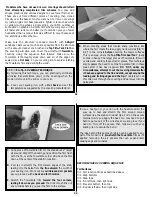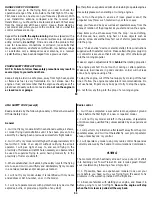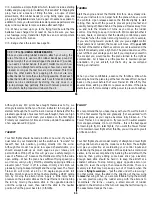
landing. Moving the balance aft makes the model more agile
with a lighter and snappier feel. Please start at the location we
recommend and do not at any time balance your model outside
the recommended range.
❍
2. Mount the wing to the fuselage with rubber bands or bolts.
The engine, muffler and propeller should also be mounted for the
C.G. check.
❍
3. Set the fuel tank (empty) on top of the fuel tank hatch to
simulate the actual weight distribution of the finished model with
the tank installed. With the wing attached to the fuselage, lift the
model with your finger tips at the balance point. If the tail drops
when you lift, the model is "tail heavy" and you must move the
battery and/or the servo tray toward the nose to achieve balance.
If the nose drops, it's "nose heavy" and you must move the battery
and/or servo tray the tail to achieve balance. The C.G. is always
determined with the fuel tank empty.
❍
4. Balance the model by shifting the receiver battery, servo tray
and receiver, then re-testing. When balance is obtained note the
position of the of the receiver, servo tray and the battery pack.
❍
5. If the balance cannot be achieved by positioning the battery,
servo tray and receiver, you may add stick-on lead weight to the
tail or nose if required.
❍
6. Confirm that the battery is securely wrapped in foam and is
packed in tight enough under the tank floor so that it cannot shift
during flight or a rough landing.
❍
7. If you haven't already done so, assemble the fuel tank
according to the manufacturer’s instructions. Connect about 6" of
medium silicone fuel line to the "vent" and about 10" of fuel line to
the "pickup" fittings on the tank (most modelers leave the third "fill"
line closed because you can fill the tank through the pickup line).
❍
8. Cover the tank floor with 1/4" foam rubber. Insert the tank into
the tank compartment as you route the fuel lines through the holes
you drilled in the firewall (you may temporarily remove the servo
tray – or just the throttle servo). Cut the lines to the proper length
and connect them to the carburetor and muffler pressure fitting.
❍
9. Place more foam on the sides and top of the tank.
❍
10. Glue the servo tray securely to the fuse doublers and fuse
sides with medium CA at the position required to achieve balance.
IMPORTANT: After the model is 100% complete, recheck
the balance.
49
CHECKS AND FINAL SETUP
❍
1. IMPORTANT: Go back and check your installation. Be sure that
all servo screws, horns, and other components are secure. Confirm
that you have installed the retainers on the screw-lock connectors.
❍
2. Apply a strip of 1/16" thick foam wing-seating tape to the
wing saddle. This tape provides a seal against dirt and exhaust oil,
and cushions the wing from vibration.
❍
3. Check the direction of all control functions. They must all
move in the direction shown in the following sketches. If not,
change the position of the reversing switches on your transmitter.
CONTROL SURFACE THROWS
We recommend the following Control Surface Throws:
NOTE: Control throw (movement) is measured at the trailing
edge of the elevator, rudder, and ailerons. Hold a ruler vertically
on your workbench or block it up on books to make these
measurements.
Note: If your radio system does not feature Adjustable Travel
Volume (ATV's), you will have to mechanically adjust control
surface throw.
The following throws are for a transmitter that does not have
Dual Rates.
ELEVATOR:
1/2" up
3/8" down
RUDDER:
3/8" right
3/8" left
AILERONS:
3/8" up
3/8" down
NOTE: The balance and control throws for the Tower Trainer
40 have been thoroughly tested and represent the settings at
which the Trainer flies best. Please set up your Tower Trainer
40 to the specifications listed. If, after a few flights, you
would like to adjust the throws to suit your taste, that's fine.
Remember, "
more is not better."
CARBURETOR WIDE OPEN
RUDDER MOVES RIGHT
LEFT AILERON MOVES DOWN
RIGHT AILERON MOVES UP
ELEVATOR MOVES UP
4-CHANNEL
TRANSMITTER
(STANDARD MODE 2)
4-CHANNEL RADIO SETUP
TRANSMITTER
4-CHANNEL
TRANSMITTER
4-CHANNEL
TRANSMITTER
4-CHANNEL
50

